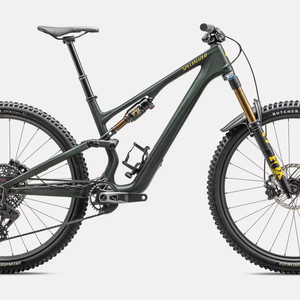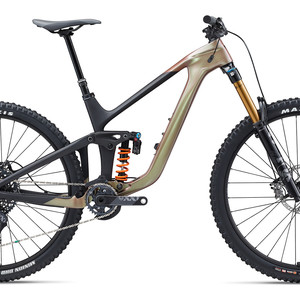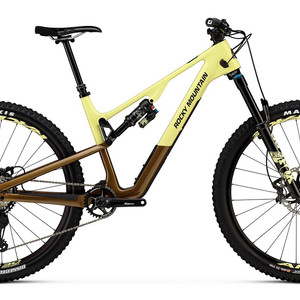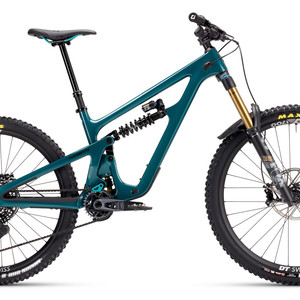2018 Scott Genius 700/900 Tuned Bike
(discontinued)
| Where To Buy | |||
|---|---|---|---|
Free shipping on orders over $50 (continental U.S. only).
International shipping available. Some exclusions apply. |
|||
Free shipping on orders over $50 (continental U.S. only).
International shipping available. Some exclusions apply. |
|||

Billed as the Swiss brand’s take on the ultimate do-it-all shredder, the Genius is an important bike for Scott. It sits squarely in the all-mountain segment, but thanks to a nifty multi-mode suspension platform and generally low weight, it can venture out on either side of its principal raison d’etre without getting in too deep over its head. For 2018, Scott has gone back to the drawing board to come up with an entirely new bike, and we headed over to the magnificent Valle d’Aosta in Italy to give it a spin. Read on to find out what we think of it.
2018 Scott Genius 700/900 Tuned Highlights
- Full carbon frame
- 150mm travel front/rear
- Boost front and rear
- Horst Link rear suspension layout
- Designed for 27.5 and 29 inch wheels
- Flip Chip geo adjust
- BB92 pressfit bottom bracket
- E2 pressfit headset
- Front derailleur compatible
- Internal cable routing
- Availability: late September 2017
- Weight: ~12.4kg (medium, 900 Tuned)
- Pricing: TBA
Two Bikes in One - TwinLoc
When Scott originally set out to build an all-mountain bike, they took a few decisions that affect the design and the technologies chosen for the task. For example, they firmly believe that to create a bike that combines true uphill prowess with robust capacities on the way back down, the best solution is to rely on different suspension modes and travel adjust features. The current version of the Genius already features Scott’s TwinLoc technology, which allows the rider to select one of three different suspension modes directly from the handlebar – each of which affects both the shock and the fork. For the 2018 edition, the same concept carries over.

The Scott-specific FOX Nude shock features dual positive air chambers, one of which can be closed off to reduce the amount of rear wheel travel from 150mm to about 110mm in “Trail Mode”. At the same time, low speed compression damping is increased to help combat pedal bob. The result is a bike that rides higher in its travel, thus positioning the rider ideally for climbing, while it also bobs less. The fork is also connected to the TwinLoc lever via its compression adjuster. In Trail Mode, the low speed compression increases to provide more support up front, and give the rider more of a platform to work against for out-of-the-saddle efforts or for pumping the terrain.



The Lockout mode locks both the shock and the fork, and although a blow-off valve is present, this mode it not meant for trail riding. It was designed for maximum efficiency on long, smooth pedaling or transfer sections, like riding the road for a few miles to get to your local trails, for example.
Big Wheels Keep On Turning
Next on the design menu, wheels. Or to be more specific, wheels and tires. Scott took a long hard look at what is going on in the wheel world, and came to the conclusion that they could build an all-mountain bike that can easily switch between what they feel are the only wheel sizes that are really needed in this segment: 27.5(+) and 29. After having tested pretty much everything that is out there, they concluded that the sweet spot for so-called plus tire width lies between 2.6 and 2.8 (never more), and that within this range of sizes, the actual differences in tire width and volume are so small that a simple flip chip solution in the frame coupled with a 29er boost fork allows you to run multiple wheel sizes on the same platform. Good bye, confusing choices for the consumer. Good bye, complex catalogs and stock issues for the dealers. After having been one of the very first to adopt the regular 27.5 wheel size, Scott is now among the very first to push ahead and essentially abandon it on its All-Mountain bikes (they will no longer sell a “classic” 27.5 bike in this segment).
To illustrate the wheel size aspect more clearly, take a look at the following 4 tires, starting from the left (all measured on a 30mm wide rim at 18.5psi). There's less in it than you think:
| Schwalbe Nobby Nic | Maxxis Rekon | Maxxis Minion WT | Schwalbe Nobby Nic |
| 27.5/2.8, 69mm wide | 27.5/2.8, 63mm wide | 27.5/2.5, 62.5mm wide | 29/2.6, 62mm wide |

A Pivotal Moment – Scott Goes Horst Link
Scott bikes have used a single-pivot rear suspension layout for a long time. But when it came down to designing the new Genius, Scott found that the recently out-of-patent Horst Link would allow them to reach their design goals even easier. They also took the opportunity to inverse the suspension curve of the old Genius, which was a regressive design, to bring the new Genius up to speed and on trend. The new curve is quite progressive, which allows for great small-bump compliance with ample end stroke support to ward off the bottom-out issues that often plagued the previous version of the bike. Scott also optimized the anti-squat and kickback numbers for middle-of-the-road pedaling efficiency, knowing that they have an ace up their sleeve with their travel/damping adjust feature.



The World’s Lightest AM Frame?
Another traditional Scott hallmark is weight, or rather the distinct absence thereof. Scott has always taken pride in producing light bikes, and for the 2018 version of the carbon Genius, they set the bar even higher. The goal was lowest-in-class total frame weight, and although we have not been able to verify that claim, we have no problem believing Scott when they said they succeeded. We put the new frame on the scales at the launch and we saw it come in at an impressive 2180 grams, complete with shock, frame hardware, and protective elements such as the chain slap guard and the BB guard.

To achieve these numbers whilst still delivering a frame that will be strong enough for modern all-mountain riding, Scott invested a lot of R&D resources into difference carbon technologies, and ultimately came up with a design that involves more than 900 different pieces of carbon weave. The area around the BB was given extra attention, to make sure it would be strong enough to give the frame excellent power transfer characteristics thanks to a direct and strong connection between the bottom tube, the BB, and the chain stays. This part of the frame alone requires 150 individual pieces of carbon weave in the layup. The move to a shorter, Trunnion-mount shock also helps increase the stiffness and rigidity in this part of the frame. Cable routing is internal, and there is room for a Shimano Di2 battery in the frame as well. At the launch, Scott had a cut-away on hand to help illustrate the design concepts:




Geometry
Scott had us ride the bike before divulging any geometry numbers, which was a great way to put us journalists on the spot. We made some educated guesses, and we came out pretty close on head angle, seat tube angle, and chain stay length, whilst the reach surprised us by being a bit more generous than we thought after riding the bike. The bike we rode features a new, fully integrated bar-stem carbon job from house brand Syncros, which did seem to translate to a slightly shorter effective cockpit, partially explaining us getting the reach number wrong when trying to guess it. Be that as it may, Scott’s new Genius is resolutely modern with its 65-65.6 degree head angle, 436mm chainstays, and 472mm reach on the size L. The seat tube comes in at around 75 degrees effective (depending on flip chip configuration), which should put the rider in an ideal position for going back up the hill.

On The Trail
The Aosta Valley sits in the heart of Alps, in the figurative shadow of the Mont Blanc and the Matterhorn, surrounded by jagged peaks and tasty ridgelines. Earning your turns here means thousands of feet of climbing, rewarded by long descents that put both man and machine to the test. We arrived after an unusually long dry spell and were greeted with two days of torrid heat, which added pain to the climbs and a layer of dust to the trails that served to up the challenge even more. Scott shredders and Deathgrip buddies Brendan Fairclough and Andrew Neethling were also on hand to help us feel extra inadequate.


We rode the bike in the 27.5+ configuration on the first day, setting out for a pedal-powered loop that took in everything from sweeping forest trails to rowdy rocky sections that kept us on our toes. The Genius is an easy bike to live with, both on the ups and the downs. The climbing position is excellent, which unusually for this tester left us not even looking to move the saddle as far forward as it will go on its rails. The bike bobs quite a bit if left in the open mode, but there is still enough support in the suspension to not give you that sagged-behind-the-rear-wheel feeling, even on steeper climbs – testament to the steep seat tube angle doing its job. Switching into Trail mode (by pressing the TwinLoc lever to the first click) has a marked effect on pedal bob and holds the rider’s weight up even more, which leads to a marked improvement in pedaling efficiency. We found the Lockout mode to be a further improvement on pedaling efficiency, but at the cost of comfort and uphill agility. Even slightly bumpy fire roads are quite uncomfortable in the Lockout mode, not because of the shock being locked but much more so the fork, and we quickly elected to only use it on super smooth dirt road sections or tarmac outright.

Time to point the bike down the hill! But first things first – time to try to remember what all those levers do. Specifically, we found the choice of putting the TwinLoc lever under the grip unfortunate, as this is where more and more riders are used to finding their dropper post remote (particularly since Scott does have a version that sits on top of the bars available). Of course, you get used to such things after a while, but it still lead to some comedy moments where instead of dropping our seats ahead of a gnarly section we’d end up just locking out our suspension instead, which has quite the opposite effect…! The lever itself is easy to work with, and although it does not outright mimic the movement of a shifter, it is intuitive in use.
The 150mm of available travel is smooth and well controlled, and we felt Scott did a particularly good job of balancing suppleness with bottom-out support.


Once in open mode, the new Genius is a capable and fun ride. Even on our FOX 36 equipped Tuned model (the only Genius in the range with a 36 instead of a 34), the rear did an admirable job of keeping up with the front. The 150mm of available travel is smooth and well controlled, and we felt Scott did a particularly good job of balancing suppleness with bottom-out support. Although our test loops did not include any particularly massive features, we still did our best to try and hit the bottom of the shock, without much luck. At the same time, we found little of the harshness that can sometimes haunt progressive Horst Link-equipped bikes. The bike is poppy and playful, and the very low weight makes it easy to pick up and place where you want to. When the trail levels out a bit, we also got good results putting the bike back into Trail mode, especially when it came to pumping for speed.


On day two, we swapped our hoops, flipped the chip, and headed out for a big all-day adventure on the wagon wheel version. We rode both wheelsets with the same Maxxis Rekon tires, in 2.8 on the 27.5+, and 2.6 on the 29er. Overall, we did not find a big difference between the two configurations, in both cases we did find the choice of rubber held us back a bit in the particularly dry and loose conditions we were confronted with this week, even when running the lower pressures that these big tires can let you get away with. This tester was spared but there were also quite a few flats in the group. As always, it comes down to where and what you ride, but we’d have no second thoughts about throwing a 2.6 Minion up front, for example.

Although it’s hard to provide a conclusive opinion after just two days of testing, we would probably prefer the 29er version should we get a new Genius for ourselves. Running the flip chip in the lower position (to compensate for the taller wheels) also slackens out the head angle a bit (and since the fork offset remains the the same this also lengthens the trail measure), and we felt that the bike inspired more confidence in this setting. It may just have been us getting used to the terrain as well, but the 2.6/29er version of the tire seemed to dig in bit better than the meatier 2.8/27.5, and the increased diameter of the wheel took the sting out of the rowdier sections. We never felt awkward either way, the bike remains quite agile and it is definitely fun to ride in both versions. Now, given how much you can do with this 150mm version, we're certainly also intrigued at the prospect of a future LT model...we don't have a release date for that one, but we were told it's coming at some point too. Should be quite the ride!
Build Kit
A few comments on the build kit of our 700/900 Tuned version:
- Overall, the suspension does a great job. The FOX 36 up front may seem like overkill on an all-mountain bike, especially since it is held to just 150mm of travel here, but it did not feel out of place and the excellent rear suspension does a great job of keeping up (the rest of the lineup features the 34). The frame layout chosen by Scott makes room for a water bottle and allows them to run very clean cable routing to the rear shock, but it also limits the aftermarket shock options that can be used, specifically piggy-back shocks. We'd argue that such shocks are not squarely within the intended range of use cases of the Genius, but given how capable the frame is, more than a few could be tempted by such upgrades (at the expense of the travel/damping adjustments in that case).


- We did not have great results with the new integrated bar-stem combo from Syncros (Scott’s house brand for components). Apart from it showing up a mere 760mm wide (we thought we were past this by now, it is 2017 after all!), we also had it slip on the steer tube after a minor incident, and we had to crank down the grip lockrings as hard as we could to stop them from slipping. Scott told us that final production models will have additional sanding work and a clear coat to remedy this issue. Visually, the shape is also a bit unsettling at first, although once the trail gets interesting you won’t notice this aspect anymore - and at a mere 290 grams for the whole thing, you do save quite a bit of weight. Note that although this integrated cockpit seems super short when you first look at it, it is actually modeled around a classic 50mm stem and bar combo, which should leave the grips in more or less the same spot as usual (we felt like it might be a bit shorter overall). If you prefer a classic bar/stem combo, you will have to splurge on both items.



- The SRAM Guide RSC brakes worked well over the course of the two days, with adequate power on tap and no tendency to fade even on the longer descents. We do think that the Tuned version would benefit from a 200mm rotor up front, especially since there’s already a 36 up there anyway. It would make for a more harmonious and appropriate build.
- The Maxxis Rekon tires lacked a bit of bite, and although we did not have any flats on our test bike, there were quite a few in the group who did. The DT Swiss wheels themselves felt good during testing, their 30mm internal width rims offering up what felt like a good ratio of weight to stiffness. Scott says you can run anything from a 2.5 to a 2.8 tire for the 27.5 version (2.4 to 2.6 for the 29er), which means you have an increasingly big palette of rubber to choose from. There is plenty of room in the fork too.
- The FOX Transfer dropper post is an excellent bit of kit, although we much prefer to run it with a shifter style lever. This would be made possible if Scott were to spec the above-bar version of its Twinloc lever instead.




Build Kits
The new Genius is available in a broad range of configurations with multiple wheelsize options across several price points, starting from the hot rod-esque 700 Ultimate right down to the entry-level 750.


Genius 700 Ultimate


Genius 900 | 700 Tuned



Genius 710


Genius 720 | 920



Genius 730 | 930



Genius 740 | 940



Genius 750


What’s The Bottom Line?
The Genius platform is Scott’s best selling bike, and a critical component in the lineup. The 2018 edition has been brought right up to date in all the important aspects, while retaining the unique traits that make it a Scott. The travel/geo/damping adjust feature is unique in the market (no other brand offers the same comprehensive combo), whilst the rest of the bike remains lightweight and very capable. Call it Trail, call it All-Mountain, call it Enduro Light, if your jam is going up and down mountains all day long, you could certainly do a lot worse than the new Genius.
More information at: www.scott-sports.com.
Vital MTB First Ride Rating
- Climbing: 4.5 stars - Outstanding
- Descending: 4 stars - Excellent
- Fun Factor: 4 stars - Excellent
- Value: Pricing still TBA
- Overall Impression: 4 stars – Excellent (pending pricing info)
About The Reviewer
Johan Hjord loves bikes, which strangely doesn’t make him any better at riding them. After many years spent practicing falling off cliffs with his snowboard, he took up mountain biking in 2005. Ever since, he’s mostly been riding bikes with too much suspension travel to cover up his many flaws as a rider. His 200-pound body weight coupled with unique skill for poor line choice and clumsy landings make him an expert on durability - if parts survive Johan, they’re pretty much okay for anybody. Johan rides flat pedals with a riding style that he describes as "none" (when in actuality he rips!). Having found most trail features to be not to his liking, Johan uses much of his spare time building his own. Johan’s other accomplishments include surviving this far and helping keep the Vital Media Machine’s stoke dial firmly on 11.
Photos by Johan Hjord and Scott/Markus Greber (action and studio)
Specifications
900 Series: Schwalbe Nobby Nic, 2.6" x 29", EVO, Snake Skin, tubeless easy, Addix Speedgrip
Horst Link rear suspension layout
Designed for 27.5" and 29" wheels
Front derailleur compatible
27.5" (2.6" and 2.8") and 29" (2.4" and 2.6") tire compatible with flip chip geometry/bottom bracket adjust
TBC Trunnion box construction
Includes a Syncros trail fender
| Where To Buy | |||
|---|---|---|---|
Free shipping on orders over $50 (continental U.S. only).
International shipping available. Some exclusions apply. |
|||
Free shipping on orders over $50 (continental U.S. only).
International shipping available. Some exclusions apply. |
|||


























0 comments
Post a reply to: First Ride: 2018 Scott Genius 700/900 Tuned – A Swiss Army Trail